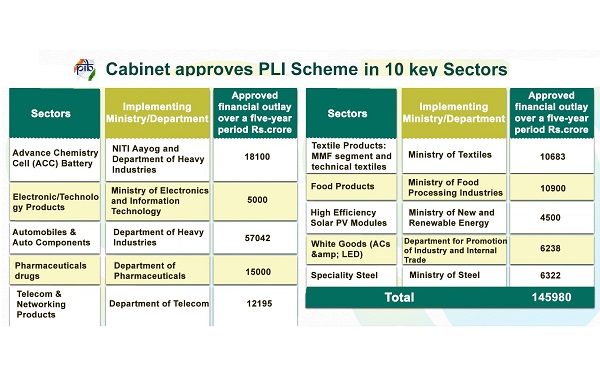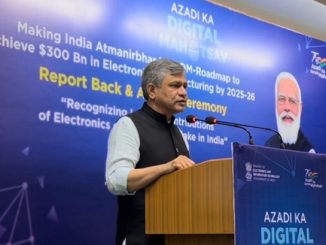
Nov 11: The Union Cabinet chaired by the Prime Minister, Shri Narendra Modi has given its approval to introduce the Production-Linked Incentive (PLI) Scheme in the following 10 key sectors for Enhancing India’s Manufacturing Capabilities and Enhancing Exports – Atmanirbhar Bharat.
| Priority | Sectors | Implementing Ministry/Department | Approved financial outlay over a five-year period Rs.crore |
| Advance ChemistryCell (ACC) Battery | NITI Aayog and Department of Heavy Industries | 18100 | |
| Electronic/Technology Products | Ministry of Electronics and Information Technology | 5000 | |
| Automobiles & Auto Components | Department of Heavy Industries | 57042 | |
| Pharmaceuticals drugs | Department of Pharmaceuticals | 15000 | |
| Telecom & Networking Products | Department of Telecom | 12195 | |
| Textile Products: MMF segment and technical textiles | Ministry of Textiles | 10683 | |
| Food Products | Ministry of Food Processing Industries | 10900 | |
| High Efficiency Solar PV Modules | Ministry of New and Renewable Energy | 4500 | |
| White Goods (ACs & LED) | Department for Promotion of Industry and Internal Trade | 6238 | |
| Speciality Steel | Ministry of Steel | 6322 | |
| Total | 145980 |
The PLI scheme will be implemented by the concerned ministries/departments and will be within the overall financial limits prescribed. The final proposals of PLI for individual sectors will be appraised by the Expenditure Finance Committee (EFC) and approved by the Cabinet. Savings, if any, from one PLI scheme of an approved sector can be utilized to fund that of another approved sector by the Empowered Group of Secretaries. Any new sector for PLI will require fresh approval of the Cabinet.
The PLI scheme across these 10 key specific sectors will make Indian manufacturers globally competitive, attract investment in the areas of core competency and cutting-edge technology; ensure efficiencies; create economies of scale; enhance exports and make India an integral part of the global supply chain.
- ACC battery manufacturing represents one of the largest economic opportunities of the twenty-first century for several global growth sectors, such as consumer electronics, electric vehicles, and renewable energy. The PLI scheme for ACC battery will incentivize large domestic and international players in establishing a competitive ACC battery set-up in the country.
- India is expected to have a USD 1 trillion digital economy by 2025. Additionally, the Government’s push for data localization, Internet of Things market in India, projects such as Smart City and Digital India are expected to increase the demand for electronic products. The PLI scheme will boost the production of electronic products in India.
- The automotive industry is a major economic contributor in India. The PLI scheme will make the Indian automotive Industry more competitive and will enhance globalization of the Indian automotive sector.
- The Indian pharmaceutical industry is the third largest in the world by volume and 14th largest in terms of value. It contributes 3.5% of the total drugs and medicines exported globally. India possesses the complete ecosystem for development and manufacturing of pharmaceuticals and a robust ecosystem of allied industries. The PLI scheme will incentivize the global and domestic players to engage in high value production.
- Telecom equipment forms a critical and strategic element of building a secured telecom infrastructure and India aspires to become a major original equipment manufacturer of telecom and networking products. The PLI scheme is expected to attract large investments from global players and help domestic companies seize the emerging opportunities and become big players in the export market.
- The Indian textile industry is one of the largest in the world and has a share of ~5% of global exports in textiles and apparel. But India’s share in the manmade fibre (MMF) segment is low in contrast to the global consumptionpattern, which is majorly in this segment. The PLI scheme will attract large investment in the sector to further boost domestic manufacturing, especially in the MMF segment and technical textiles.
- The growth of the processed food industry leads to better price for farmers and reduces high levels of wastage. Specific product lines having high growth potential and capabilities to generate medium- to large-scale employment have been identified for providing support through PLI scheme.
Large imports of solar PV panels pose risks in supply-chain resilience and
have strategic security challenges considering the electronic (hackable) nature of the value chain. A focused PLI scheme for solar PV modules will incentivize domestic and global players to build large-scale solar PV capacity in India and help India leapfrog in capturing the global value chains for solar PV manufacturing.
- White goods (air conditioners and LEDs) have very high potential of domestic value addition and making these products globally competitive. A PLI scheme for the sector will lead to more domestic manufacturing, generation of jobs and increased exports.
- Steel is a strategically important industry and India is the world’s second largest steel producer in the world. It is a net exporter of finished steel and has the potential to become a champion in certain grades of steel. A PLI scheme in Specialty Steel will help in enhancing manufacturing capabilities for value added steel leading to increase in total exports.
The above will be in addition to the already notified PLI schemes in the following sectors:
| No. | Sectors | Implementing Ministry / Department | Financial outlaysRs. crore |
| 1 | Mobile Manufacturing and Specified ElectronicComponents | MEITY | 40951 |
| 2 | Critical Key Starting materials/Drug Intermediaries and Active Pharmaceutical Ingredients | Department of Pharmaceuticals | 6940 |
| 3 | Manufacturing of MedicalDevices. | 3420 | |
| Total | 51311 |
The Prime Minister’s clarion call for an ‘AatmaNirbhar Bharat’ envisages policies for the promotion of an efficient, equitable and resilient manufacturing sector in the country.Growth in production and exports of industrial goods will greatly expose the Indian industry to foreign competition and ideas, which will help in improving its capabilities to innovate further. Promotion of the manufacturing sector and creation of a conducive manufacturing ecosystem will not only enable integration with global supply chains but also establish backward linkages with the MSME sector in the country. It will lead to overall growth in the economy and create huge employment opportunities.
Sector Wise Product Lines
| Sector | Product Lines |
| AdvanceChemistry Cell (ACC) Battery Manufacturing | ACC Batteries |
| Electronic/Technology Products | Semiconductor FabDisplay FabLaptop/ NotebooksServersIoT DevicesSpecified Computer Hardware |
| Automobile andAuto Components | Automobile and Auto Components |
| Pharmaceuticals | Category 1BiopharmaceuticalsComplex generic drugsPatented drugs or drugs nearing patent expiryCell based or gene therapy productsOrphan drugsSpecial empty capsulesvii. Complex excipients |
| Category 2Active Pharma Ingredients (APIs) /Key Starting Materials (KSMs) and /Drug Intermediaries (Dls)Category 3Repurposed DrugsAuto-immune drugs, Anti-cancer drugs, Anti diabetic drugs, Anti Infective drugs, Cardiovascular drugs,Psychotropic drugs and Anti-Retroviral drugsIn-vitro Diagnostic Devices (IVDs)PhytopharmaceuticalsOther drugs not manufactured in IndiaOther drugs as approved | |
| Telecom Products | Core Transmission Equipment4G/5G, Next Generation Radio Access Network and Wireless EquipmentAccess & Customer Premises Equipment (CPE), Internet of Things (IoT) Access Devices and Other WirelessEquipmentEnterprise equipment: Switches, Router |
| Textiles | Man-Made Fiber SegmentTechnical Textiles |
| Food Processing | Ready to Eat / Ready to Cook (RTE/ RTC)Marine ProductsFruits & VegetablesHoneyDesi GheeMozzarella CheeseOrganic eggs and poultry meat |
| Solar PV manufacturing | Solar PVs |
| White Goods | Air conditionersLED |
| Steel Products | Coated SteelHigh Strength SteelSteel RailsAlly Steel Bars & Rods |



